Diversity in Tech Statistics 2024 – By Countries, Companies And Demographic (Age, Gender, Race, Education)
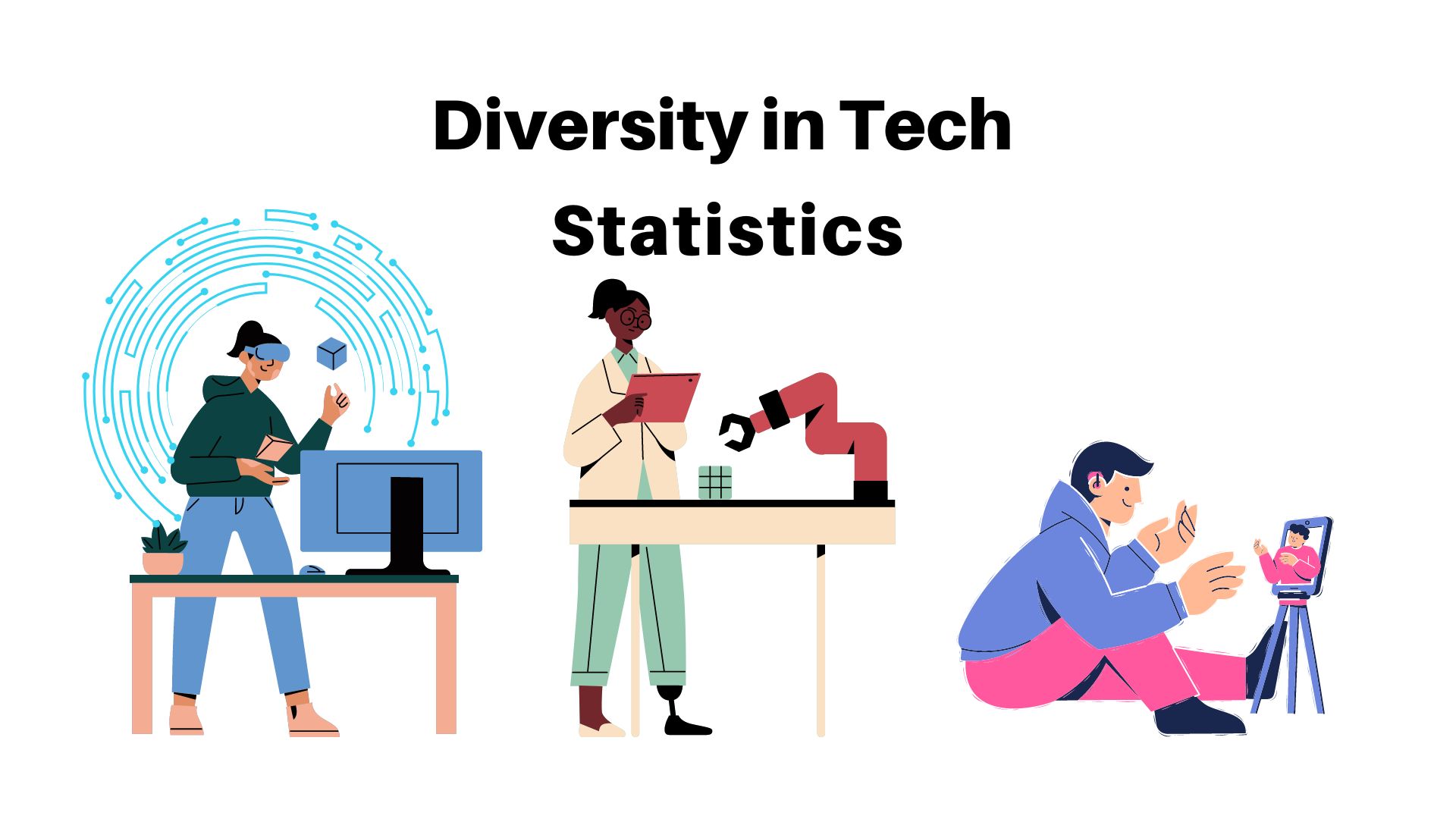
Page Contents
- Introduction
- Editor’s Choice
- What Is Diversity And Why Diversity Is Important?
- Facts About Diversity in Tech
- General Diversity in Tech Statistics
- Diversity in Tech by Demographic (Age, Gender, Race, Education)
- Diversity In Tech By Countries
- US Diversity in Tech Statistics
- Diversity in Tech By Companies
- Diversity in Tech – Trends and Predictions
- Recent Developments In Diversity In Tech
- Conclusion
Introduction
Diversity in Tech Statistics: In today's tech-driven world, discussions about diversity in the technology sector have gained significant traction. Recent statistics shed light on the disparities and opportunities within this industry. According to data from various sources, including reports from leading tech companies and diversity advocacy groups, the lack of diversity remains a prominent issue. For example, studies reveal that only 25% of computing jobs in the United States are held by women, while Black and Hispanic individuals make up just 9% of the tech workforce combined.
Additionally, research indicates that LGBTQ+ individuals are underrepresented in tech, with only 2.3% of tech workers identifying as LGBTQ+. Despite these challenges, there are promising signs of progress. Companies are increasingly recognizing the importance of diversity and inclusion initiatives, with some allocating significant resources to address these issues. For instance, tech giants like Google and Microsoft have committed millions of USD to diversity programs aimed at recruiting and retaining underrepresented talent. As discussions surrounding diversity in tech continue to evolve, understanding the statistical landscape is crucial in fostering meaningful change and creating a more inclusive industry for all.
Editor’s Choice
- In 2021, 7.9% of the US labor force was employed in technology.
- Women hold only 26.7% of tech employment, while men hold 73.3% of these positions.
- White Americans hold 62.5% of the positions in the US tech sector. Asian Americans account for 20% of jobs, Latinx Americans 8%, and Black Americans 7%.
- 83.3% of tech executives in the US are white.
- Black Americans comprised 14% of the population in 2019 but held only 7% of tech employment.
- For the same position, at the same business, and with the same experience, women in tech are typically paid 3% less than men.
- The high-tech sector employs more men (64% against 52%), Asian Americans (14% compared to 5.8%), and white people (68.5% versus 63.5%) compared to other industries.
- The tech industry is urged to prioritize inclusion when hiring, mentoring, and retaining employees to bridge the digital skills gap.
- Black professionals only account for 4% of all tech workers despite being 13% of the US workforce.
- Hispanic professionals hold just 8% of all STEM jobs despite being 17% of the national workforce.
- Only 22% of workers in tech are ethnic minorities.
- Gender diversity in tech is low, with just 26% of jobs in computer-related sectors occupied by women.
- Companies with diverse teams have higher profitability, with those in the top quartile for gender diversity being 25% more likely to have above-average profitability.
- Every month, the tech industry adds about 9,600 jobs to the U.S. economy.
- Between May 2009 and May 2015, over 800,000 net STEM jobs were added to the U.S. economy.
- STEM jobs are expected to grow by another 8.9% between 2015 and 2024.
- The percentage of black and Hispanic employees at major tech companies is very low, making up just one to three percent of the tech workforce.
- Tech hiring relies heavily on poaching and incentives, creating an unsustainable ecosystem ripe for disruption.
- Recruiters have a significant role in disrupting the hiring process to support diversity and inclusion.
You May Also Like To Read
- Outsourcing Statistics
- Digital Transformation Statistics
- Internet of Things Statistics
- Computer Vision Statistics
What Is Diversity And Why Diversity Is Important?
Diversity refers to the presence and inclusion of people from diverse backgrounds, such as race, ethnicity, gender, age, sexual orientation, socioeconomic position, or skills. Diversity encompasses individuals' unique viewpoints, experiences, and identities which add something unique and distinctive to an environment or situation.
Diversity is of vital importance for various reasons, chief among them creativity and innovation. When individuals from diverse backgrounds join together, their collective knowledge provides more comprehensive answers to difficult problems than an approach based solely on presumptions, conventional wisdom or conventional insights could alone. Diverse teams tend to question presumptions more often while challenging conventional wisdom more vigorously while offering novel insights, thus increasing creativity while giving their teams a competitive advantage.
Second, variety promotes social justice and fairness. By breaking down barriers and encouraging inclusiveness among historically underrepresented or marginalized groups, diversity contributes to eliminating structural injustices while creating a more just society where everyone has an equal voice at the table.
Diversity enhances decision-making processes. Dialogue involving many voices offers more perspectives to consider and results in more well-informed and knowledgeable conclusions. Furthermore, multifaceted teams can better anticipate and meet consumer requirements, leading to client happiness and loyalty.
Diversity also brings many advantages to corporate culture in addition to functional ones. It can improve employee engagement, productivity, and retention by creating an atmosphere of belongingness, respect, and acceptance within the workforce. Businesses that place high importance on diversity and inclusion attract talented personnel from various backgrounds – this in turn improves reputations while increasing the capacity to attract clients and business partners.
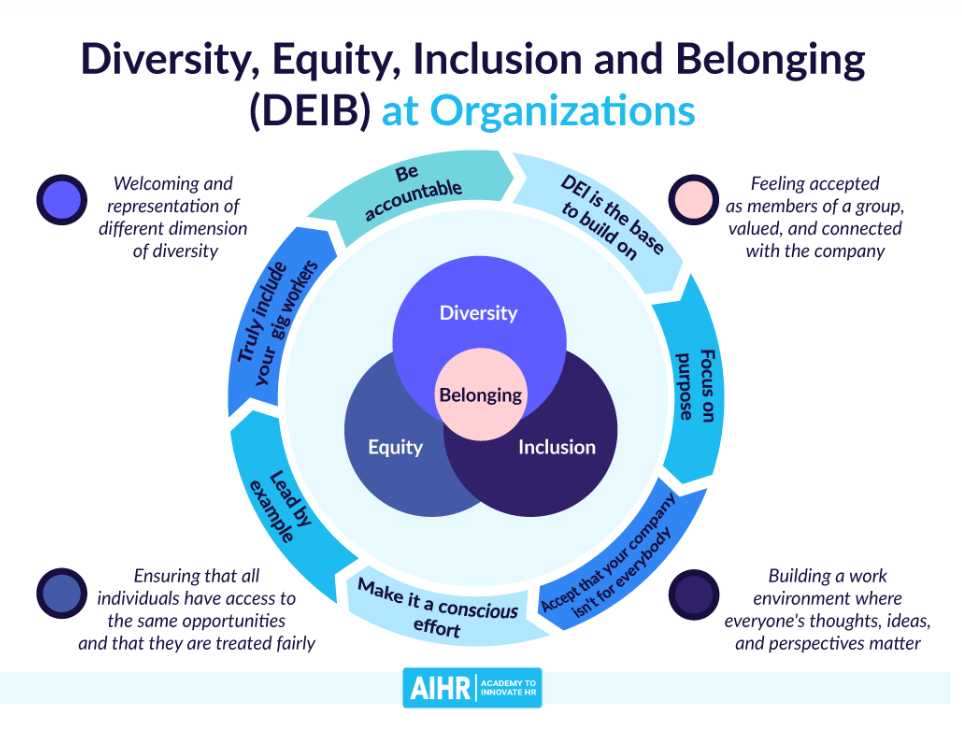
(Source: aihr.com)
Facts About Diversity in Tech
- Diversity in the tech industry remains a pressing issue, with disparities evident across gender, ethnicity, and race.
- Women are underrepresented in tech roles, holding only a fraction of positions compared to men.
- Ethnic minorities, including Black, Latinx, and Hispanic individuals, are also significantly underrepresented in the tech workforce.
- Leadership positions within tech companies are predominantly held by white individuals, highlighting a lack of diversity at the executive level.
- Studies show that diverse teams lead to higher levels of innovation and creativity, which can positively impact business outcomes.
- Despite efforts to address diversity and inclusion, progress in achieving equitable representation in the tech industry has been slow.
- Tech companies are increasingly recognizing the importance of diversity and implementing initiatives to foster a more inclusive workplace culture.
- Data indicates that diverse teams are more likely to outperform homogeneous teams in terms of financial performance and problem-solving abilities.
- The lack of diversity in tech is not only a moral imperative but also a business imperative, as companies with diverse teams are better positioned for long-term success.
- Strategies such as targeted recruitment, mentorship programs, and diversity training are being employed to address the diversity gap in the tech sector.
General Diversity in Tech Statistics
Diversity has long been an issue within the IT sector, and several statistics demonstrate how inequalities still exist today.
- Women hold only 16% of tech management positions, and only 3% of CEO positions.
- Only 44% of tech employees work at a company with a Diversity and Inclusion (D&I) department.
- Less than 30% of women are employed in tech, with black women representing under 5%.
- More than half of female technologists have experienced gender discrimination.
- Around 44% of CEOs and cofounders of tech companies experienced workplace harassment.
- Companies with over 20% female representation in senior management see better financial performance.
- Women remain underrepresented in tech jobs. According to the National Center for Women & Information Technology, in 2022 women held only 26% of professional computing jobs across the US; further, female representation continues to decrease across technical and leadership roles.
- IT providers also need to do more in terms of increasing racial and cultural diversity in their workforces, according to data from the Equal Employment Opportunity Commission (EEOC). Blacks and Latinxs only made up approximately 7% and 8%, respectively, of tech employees according to this EEOC data.
- Women currently represent 57.1 of the workforce compared to men at 69.1%.
- Apple employs approximately 30% of women and 70% of men.
- Wales boasts the highest proportion of IT workers under 35 at 51%, followed by London (48.7%) and the North East (46%).
- London stands out as having the highest concentration of women working in tech, at 28.4%; South East of England comes second at 27.7%.
- Ethnic minorities make up approximately 22% of the IT workforce.
- 92% of software developers worldwide are male.
- Only 10% of US doctoral holders in science, engineering, or medicine reported being disabled.
- 41% of programmers hold bachelor's degrees.
- At higher leadership levels, diversity becomes less significant; according to the 2022 Women in Tech Leadership Report, only 15% of executive roles at leading tech firms were filled by women; similarly, the impact of racial and ethnic minorities is limited due to their underrepresentation in executive and board positions.
- Information on LGBTQ+ individuals working in IT is scarce; however, research indicates that issues of inclusion, prejudice, and working environment impact them negatively. To effectively combat these obstacles requires creating an inclusive atmosphere.
- Economically disadvantaged individuals frequently face entry-level obstacles in the IT industry. Their ability to pursue digital jobs may be hindered by limited access to quality education, opportunities, and resources – these structural obstacles must be removed in order to foster diversity and inclusion.
- IT firms have an ageism problem, making it hard for older employees to hire or remain employed in the sector. According to a 2022 Indeed study, 53% of IT professionals aged 45 or above experienced ageism. Achieving diversity and inclusion requires accepting age differences when building IT workforces.
In order to close diversity gaps, several parties must work in cooperation. Tech businesses are leading by example with initiatives including diversity and inclusion initiatives, unconscious bias training programs, mentorship programs, and targeted recruiting techniques aimed at increasing diversity. By increasing access to education and training programs as well as outreach initiatives for underrepresented groups, a collaboration between businesses, educational institutions, and governmental organizations could play a vital role in furthering diversity promotion efforts.
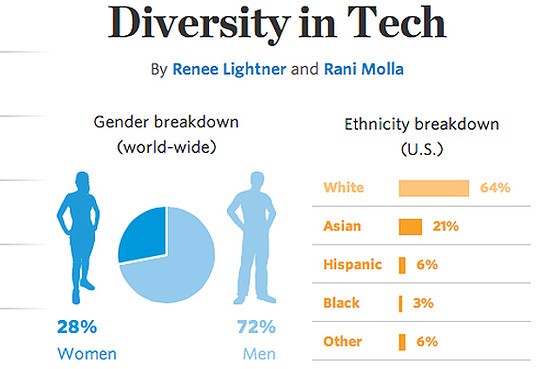
Diversity in Tech by Demographic (Age, Gender, Race, Education)
AGE
Age diversity in IT is just one of many forms of diversity present. Though no data are specifically collected on age in tech industries, trends, and observations can still be made about their population.
- IT sector professionals often create an impression of youth and an emphasis on young talent. According to U.S. Bureau of Labor Statistics data, however, computer and mathematical professionals were significantly older than the average workforce age (41.5 years in 2022), suggesting a high presence of professionals who are mid or late-career.
- Ageism is an ongoing challenge in the IT sector, where older workers may encounter prejudice and discrimination due to their age. Age discrimination may negatively impact recruitment choices, chances for professional progression, and the general perception of older workers in tech. According to reports and studies, difficulties associated with age discrimination vary based on organizations and geographical areas. It's crucial that we remember these difficulties may vary among companies or departments.
- Young IT business people often associate entrepreneurship with youth; however, senior entrepreneurs and tech company founders are becoming more common as time goes on. According to the 2022 Global Entrepreneurship Monitor (GEM) study, those aged 55-64 had the highest percentage of entrepreneurs globally – which shows senior citizens actively taking part in tech entrepreneurship by contributing their knowledge, expertise, and business sense to tech company creation.
- As technology rapidly develops, IT workers of all ages need to upskill and continue learning in order to stay current and adapt to changing technologies. Elderly IT professionals especially recognize this fact and frequently participate in ongoing education to remain current.
- Younger colleagues in IT can benefit from the leadership and mentoring provided by more experienced experts in this sector. Their expertise, understanding of business operations, and leadership abilities may aid teams and organizations while their presence in top leadership roles could differ between businesses.
Organizations and the industry as a whole may take various steps to encourage age diversity within IT.
- Promoting diverse employment methods that put experience, competence, and ability ahead of age; offering computer workers of all ages an opportunity for upskilling, reskilling, and ongoing learning.
- Encourage mentoring programs that support knowledge sharing amongst multiple age groups, promote teamwork, and tackle age discrimination through diversity and inclusion efforts, education campaigns, and awareness campaigns.
- Celebrating and rewarding the accomplishments of professionals across their career stages – including senior people. Forging an inclusive environment where different viewpoints, life experiences, and age groups are valued in leadership positions.
GENDER
Gender diversity in tech has long been an area of major concern and activism. Even though improvements have been seen, women remain grossly underrepresented in IT roles.
- Women remain significantly underrepresented in tech jobs. According to data provided by the U.S. Bureau of Labor Statistics in 2022, only 27% of computer and mathematical positions are held by women. This represents an ongoing gender inequality issue within technical jobs.
- At higher levels of leadership in tech organizations, gender disparity becomes ever more glaring. Reports indicate that only 12% of C-suite positions were held by women as of 2022 according to Women Who Tech reports.
- Gender inequality remains pervasive across technological fields such as software engineering, data science, and cybersecurity. Only 12% of professional developers globally identified as female developers according to the 2022 Stack Overflow Developer Survey; further evidence of an imbalanced gender ratio within highly technical fields.
- One in five of those studying technology is female; there have been fewer female graduates since more than two decades ago.
- Black women in IT face two difficulties. Only about 30% of all women work in tech, and even fewer black women than white counterparts work there; their significant underrepresentation indicates a failure of efforts by the industry to promote diversity and inclusion.
- One of the main issues within IT is gender pay inequality. Reports show that female computing employees make less for comparable tasks compared to their male colleagues, due to factors like occupational segregation, bias in performance reviews, and negotiation discrepancies.
- Men; currently hold 73.7%; of IT jobs.
- Studies suggest that; women's underrepresentation in IT; could be related to an absence of mentors.
- One 2022 survey discovered that 59% of male employees; with comparable positions typically earned higher wages.
- Computer science education contributes to women being underrepresented in the IT industry; only 31% of test takers taking the Advanced Placement Computer Science test in 2022 were female according to College Board data. This disparity in education causes a gender disparity in IT occupations that continues beyond college graduation.
Initiatives have been taken to promote gender diversity within the ICT sector. These initiatives include:
- Early support of computer science and STEM education for female students to create interest and involvement. Establish mentorship and support networks that give women in technology direction and role models.
- Companies should implement diversity and inclusion initiatives, such as unconscious bias training, to address structural issues and foster an inclusive culture. Furthermore, advocating for fair hiring procedures that eliminate gender-based discrimination during hiring or promotion processes.
- Encourage female participation in leadership positions through targeted initiatives, such as sponsorship opportunities and leadership development programs.
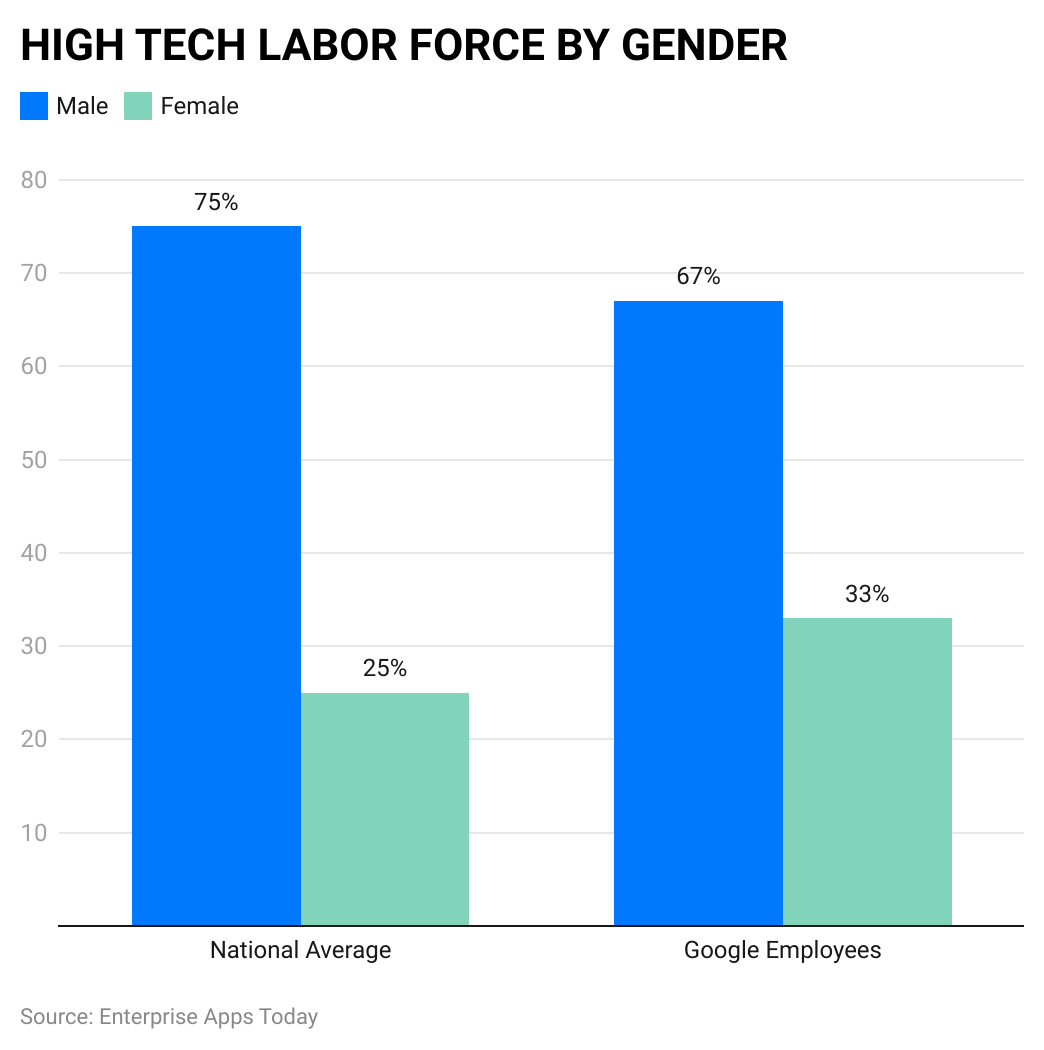
(Reference: zippia.com)
RACE
Racial and ethnic representation is diverse within the tech sector, although data shows significant gaps exist. Here are some essential numbers on diversity within tech.
- Individuals of African descent remain underrepresented in the IT field. Although Black people make up a higher portion of the population overall, they made up only around 7% of tech workers according to U.S. Equal Employment Opportunity Commission's statistics for 2022.
- Latinx individuals are underrepresented in the IT industry as well. According to EEOC data from 2022, Latinx employees made up roughly 8% of the IT workforce compared with their overall representation in population statistics.
- Asians are proportionally more prevalent in the IT sector, and specifically, those from East and South Asian heritage can be seen making significant inroads into this field. It is essential to remember that individual experiences and representation among Asians vary substantially and some ethnic groups could experience specific difficulties and underrepresentation.
- 62% of tech sector workers are white.
- One research project revealed that White job seekers in IT fields were typically offered an average annual wage of $144,000 while their Black counterparts received offers ranging between $134,000 and $154,000 instead.
- By 2022, less than 5% of workers at tech organizations will be African American.
- Few statistics exist that directly address Indigenous and Native American representation in technology sectors; however, it is widely acknowledged that Native Americans and other Indigenous peoples experience underrepresentation and disadvantage across a number of fields, including technology.
- When considering IT diversity, intersectionality must be considered. People from underrepresented racial and ethnic groups could face additional difficulty due to gender, social position, or handicapping conditions; to understand and overcome structural disparities it is vitally important to explore experiences and portrayals of people living at the intersections between race, gender, and other identities.
There have been efforts taken to promote diversity within technology.
- Initiatives for Diversity and Inclusion: Many tech businesses have implemented diversity and inclusion plans with the intention of recruiting, hiring, retaining, and promoting people from underrepresented racial and ethnic groups.
- Partnerships and Outreach: Working collaboratively on increasing representation across tech businesses, academic institutions, and community organizations is possible through strategic partnerships and targeted outreach initiatives to give underrepresented groups access to resources and opportunities.
- Initiatives that offer technical training, mentoring, and support to people from diverse backgrounds help bridge the skills gap and open doors to jobs in technology.
- Transparency of Data: Fostering transparency when reporting diversity statistics is vital to tracking progress and holding businesses accountable for fulfilling their commitment to inclusion and diversity.
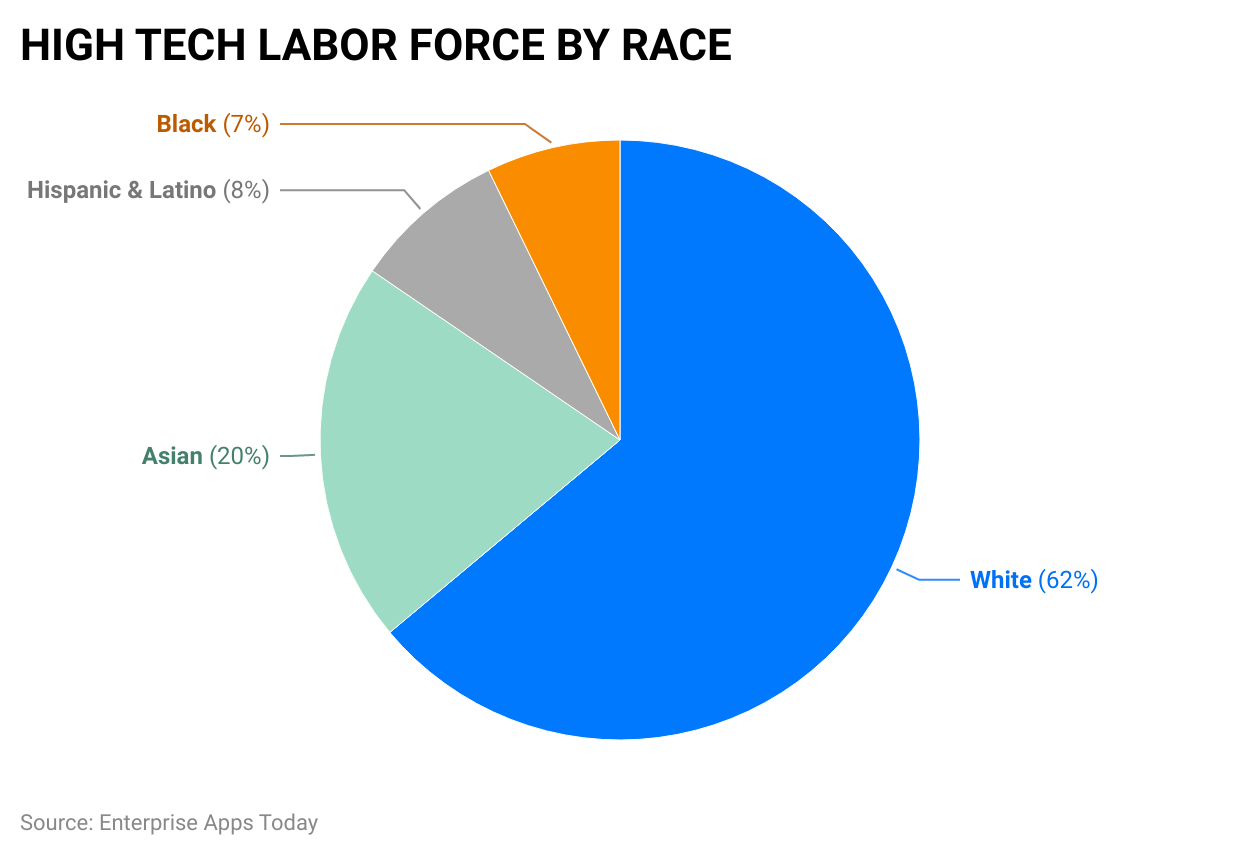
(Reference: zippia.com)
EDUCATION
IT industries are home to individuals from various educational backgrounds, with data on education revealing patterns and inequalities in the IT field. Here are some key figures pertaining to educational diversity within technology.
- Most IT workers possess at least some college education, particularly those working in computer science; engineering, and mathematics-related professions. According to data from the U.S. Bureau of Labor Statistics, 75% of computer and mathematical employment required at least a bachelor's degree by 2022.
- STEM (Science, Technology, Engineering, and Mathematics) degrees are increasingly seen as pathways into tech careers. But their attainment rates vary considerably across demographic groups – such as women or members from underrepresented racial or cultural groups being underrepresented in these degree programs.
- IT specialists don't always go the conventional educational route when entering their profession. Others opt for nontraditional learning approaches like self-study, online courses, or boot camps as ways into the computer field. Such nontraditional paths provide doors for those without formal degrees looking to enter technology professions.
- Skills-based education has become an integral component of modern IT, supplementing traditional schooling. Many computer workers acquire new abilities via workshops, internet resources, certification programs, or hands-on training. Since skills-based training may be more accessible and flexible than its academic equivalents, more people may find work within the IT industry.
- IT workers understand the necessity of continued education and skill development to stay abreast of changing technologies and market trends, including self-study programs as well as professional development initiatives.
Education can address diversity in technology in several ways.
- Increase Access to STEM Education: Promoting STEM education among underrepresented groups from an early age is integral in cultivating an array of talent. This requires creating welcoming learning settings with resources available as well as eliminating structural obstacles that obstruct access to high-quality education.
- Recognizing Alternative Routes: Employers can help increase diversity in computing by acknowledging and rewarding unconventional educational avenues like coding boot camps and skill-based training programs. When making recruiting decisions, employers should take into account each candidate's abilities, competencies, and formal education when recruiting individuals.
- Programs to Upskill and Reskill: By providing opportunities for upskilling and reskilling through training sessions, workshops, and online courses, people may enter or advance in tech industries while increasing diversity in workplace environments while closing skills gaps. Such initiatives support workplace diversity.
- Mentorship and Support: Mentorship programs can play an invaluable role in providing assistance to people from various educational backgrounds. Aspiring IT professionals may establish networks and receive guidance throughout their careers thanks to having access to experienced mentors as role models.
Diversity In Tech By Countries
Statistics demonstrate the disparate representation and inclusion levels across nations within the IT sector.
US
- Women make up roughly 26% of the computer workforce in the US, according to data provided by the National Center for Women & Information Technology.
- Racial and Ethnic Representation: According to the Equal Employment Opportunity Commission, Hispanics account for around 8% of IT jobs while African Americans make up roughly 7%.
UK
- Tech Nation estimates that women make up roughly 19% of the tech workforce.
- According to IT Nation, Black, Asian, and Minority Ethnic (BAME), people make up approximately 15% of IT industry employees.
CANADA
- Gender Representation in Canada's Computer Industry: Women comprise approximately 25% of its workforce.
- Racial and Ethnic Representation: South Asian, Chinese, and Black communities make up the bulk of visible minorities who make up around 22% of its IT sector workforce.
AUSTRALIA
- Women make up approximately 29% of Australia's IT workforce; according to statistics provided by the Australian Bureau of Statistics.
- Racial and Ethnic Representation: According to data provided by Workplace Gender Equality Agency, 11% of tech employees come from non-European backgrounds.
GERMANY
- Gender Representation: According to Bitkom, women make up approximately 16% of Germany's tech workforce.
- Racial and Ethnic Representation: According to Bitkom; 14% of IT sector employees consist of immigrants or those of migrant background.
INDIA
- Women represent approximately 34% of India's IT sector, according to data provided by the National Association of Software and Service Companies.
- Racial and Ethnic Representation: Though no information exists regarding specific ethnic representation within India's IT workforce, most IT workers there are of Indian heritage.
Note that these numbers could change depending on your data source and definitions applied to diverse groups, as well as factors like India's unique demographic makeup that could produce different dynamics.
Globally, businesses, trade organizations representing the industry, and governments are taking action against a lack of diversity in IT by creating policies of diversity and inclusion; offering educational programs for disadvantaged groups; as well as creating equitable opportunity. Initiatives include diversity and inclusion policies promotion programs creation of educational programs as well as equitable opportunity provision for underrepresented groups – among many others. Furthermore, the IT industry can strive toward increased representation by taking into account different cultures across nations by taking specific measures that foster innovation and economic growth and create an equitable workforce environment.
US Diversity in Tech Statistics
Statistics reveal significant disparities in representation across many aspects of tech, making diversity in this sector an ongoing priority.
- According to the National Center for Women & Information Technology, women comprise about 26% of the computer workforce in the US.
- Women remain underrepresented in technical professions, with estimates ranging from 20-24% of positions going unfilled.
- S. Equal Employment Opportunity Commission). Only about 7% of the computer workforce consists of African Americans despite them making up roughly 13% of the U.S. population (US Equal Employment Opportunity Commission).
- Only about 8 to 9% of IT jobs are held by Hispanics despite representing 18% of the population (U.S. Equal Employment Opportunity Commission). Even more surprising is the underrepresentation of Native Americans and Alaska Natives within this sector – just 1% or so are employed.
- Only about 24% of senior leadership roles at major tech businesses are filled by women.
- Only 10% of senior leadership positions are held by underrepresented minorities such as African Americans; Hispanics and Native Americans.
- Only around 18% of computer science degrees awarded in the US are obtained by women (National Center for Education Statistics).
- The National Center for Education Statistics estimates that 9% and 10%, respectively, of computer science graduates; come from African American and Hispanic backgrounds.
- According to the U.S. Bureau of Labor Statistics; women account for 83% of computer and mathematical jobs held by male workers.
- S. Bureau of Labor Statistics research indicates there to be significant disparities in salary between white computer workers and those belonging to other ethnicities such as African Americans or Hispanics.
Companies, organizations, and governmental bodies are taking steps to rectify such disparities through inclusive hiring practices, diversity training courses, mentorship programs, and improving educational chances for disadvantaged groups – among many other initiatives.
IT sector companies can work towards creating policies that advance equal opportunities, foster inclusive cultures, and seek the greater representation of women and underrepresented minorities by acknowledging and respecting this data. By cooperating on projects as a collective whole, this sector may benefit from multiple viewpoints which will promote innovation, better decision-making processes, and an equitable future.
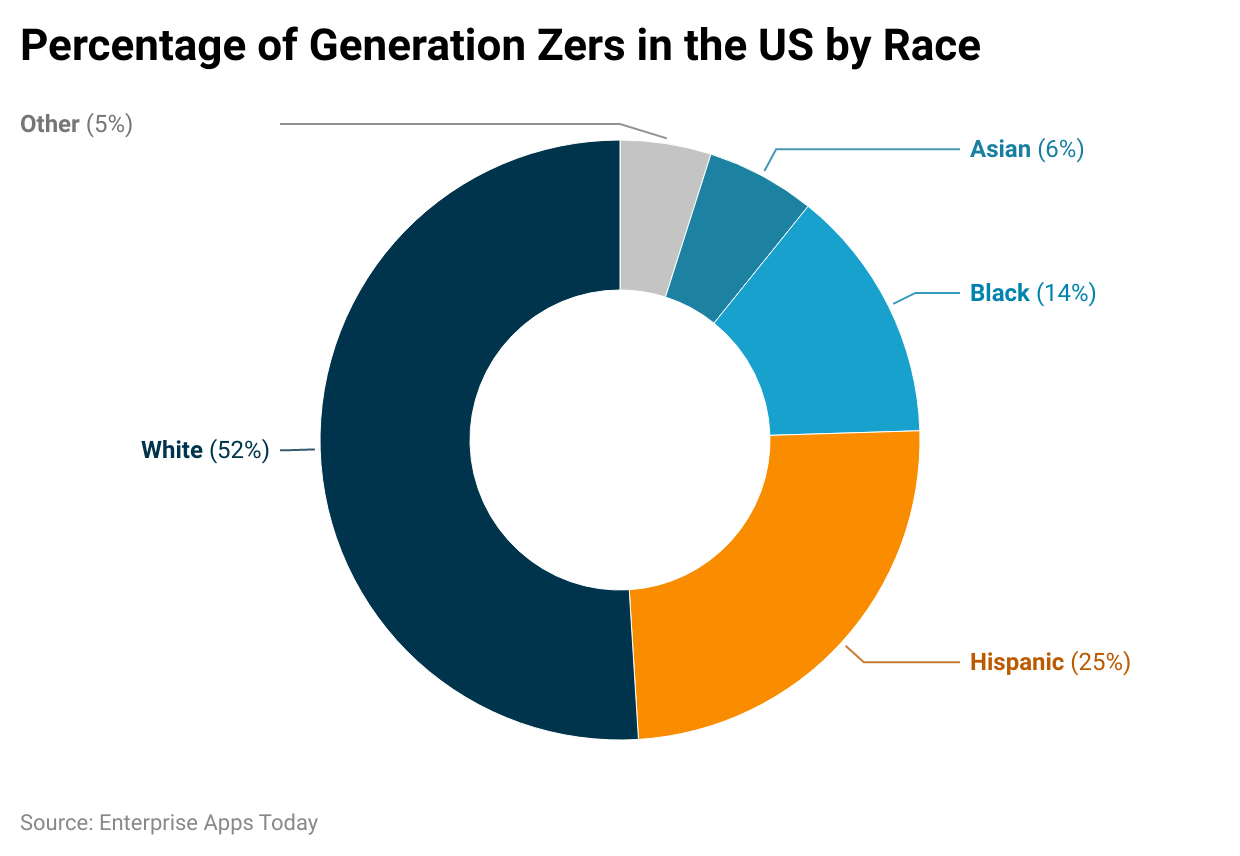
(Reference: truelist.co)
Diversity in Tech By Companies
Statistics provide insight into the representation and inclusiveness initiatives within certain corporations, while IT diversity varies across enterprises. Here are some pertinent data regarding company-level IT diversity initiatives.
- Gender Representation: According to their Diversity Annual Report, women make up approximately 33% of its overall workforce worldwide and approximately 21% in technical roles.
- Racial and Ethnic Representation: According to Google's annual Diversity Report, employees from underrepresented ethnic groups – such as Black and Hispanic workers – account for around 17% of its technical staff in the US.
Microsoft
- According to Microsoft Diversity and Inclusion Report; women represent about 29% of the global workforce while making up 24% of technical occupations.
- Racial and Ethnic Representation: According to Microsoft's Diversity and Inclusion Report, underrepresented minorities account for 11.6% of technical workers across the US.
Apple
- According to Apple's Diversity Report, women comprise 23% of technical jobs and approximately 38% of its worldwide workforce.
- Racial and Ethnic Representation: According to Apple Diversity Report; underrepresented minorities make up approximately 27% of American workforce jobs and 22% of technical positions.
- Women make up around 38% of the global workforce and approximately 24% of technical jobs worldwide, as reported in Facebook Diversity Report.
- Racial and Ethnic Representation: According to Facebook's Diversity Report, Hispanic and Black employees make up 7.3% of technical staff in the US
Amazon
- Amazon reports that women currently hold 22% of leadership roles and almost 42% of all jobs worldwide, as per its Inclusion Report.
- According to Amazon Inclusion Report, underrepresented minorities make up 29% of technical staff employed at Amazon in the US.
Figures like these emphasize the difficulty in reaching diversity and inclusion within certain businesses. Through various initiatives, IT businesses are working towards increasing representation and creating inclusive cultures; initiatives include creating inclusive recruiting procedures, offering training courses, setting up employee support networks, and encouraging openness.
These numbers shed light on the diversity situation at individual organizations, yet it's essential to remember that more must be done across the tech sector as a whole to achieve equitable representation and inclusion for all its constituents. In order to foster change that fosters a more diverse and inclusive tech environment, corporations, industry groups, and politicians all need to work collaboratively together on making this change real. Companies should actively work toward creating workplaces that fully leverage the talent of all of their personnel, leading to higher creativity, productivity, and overall success by using data analysis, setting diversity targets, and creating comprehensive policies to achieve this.
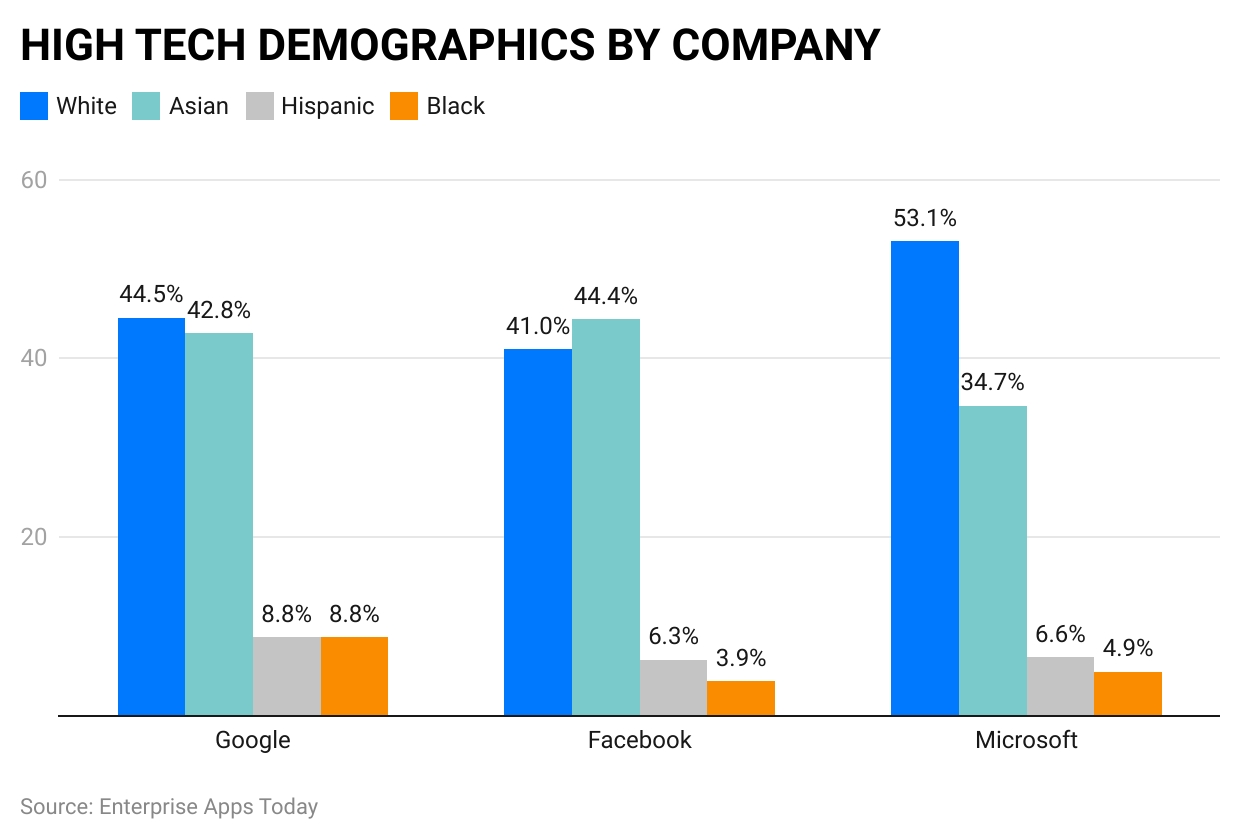
(Source: zippia.com)
Diversity in Tech – Trends and Predictions
Diversity efforts within the IT industry have recently seen increased momentum, as evidenced by various trends and projections.
- Intersectionality recognizes the fact that the experiences of individuals can be shaped by multiple aspects that interact. Inclusivity initiatives have begun taking into account people's intersecting identities such as race, gender, sexual orientation, disability, and others; tech businesses should make greater efforts in solving specific difficulties experienced by underrepresented categories.
- Diversity has expanded its definition to encompass a broader spectrum of viewpoints and experiences beyond gender and ethnicity, including neurodiversity, socioeconomic status, nationality, and other considerations. Businesses will strive to create welcoming settings which incorporate more elements of diversity.
- Businesses are using analytics and data to guide their diversity efforts, using metrics to find gaps, define objectives, and track progress. They use this information to assess project successes, make informed choices using data-backed methodologies, and promote an accountable culture through data-driven methodologies.
- Tech businesses are realizing the importance of offering services and products accessible to all users, including those with disabilities. With inclusion becoming ever more important, companies are realizing the need to design technology so it's usable by all. Inclusion design concepts must be implemented throughout product development processes in order to make technology usable by all.
- Tech organizations have seen an increased push towards diversity within senior roles. Executive and board-level efforts are being undertaken to improve the representation of underrepresented groups such as women and minorities, in an attempt to make decisions more inclusively while offering role models from such backgrounds as readily as possible.
- Businesses have long collaborated with non-governmental organizations (NGOs), educational institutions, and other groups in order to advance diversity and inclusion programs, with collaboration allowing initiatives to be amplified, best practices shared among them, and increased diversity within tech. Collaboration across industries or public/private partnerships is likely going to have the greatest effect in effecting systemic change.
- Tech businesses are emphasizing global representation and expanding their diversity initiatives beyond corporate offices. Companies have implemented programs and initiatives tailored specifically to various regions and cultures in order to foster inclusion across boundaries as companies recognize the necessity for diverse perspectives on a global scale.
Recent Developments In Diversity In Tech
- Tech companies have increasingly implemented diversity and inclusion initiatives in response to growing awareness of inequalities within the industry.
- Many organizations are investing in programs aimed at increasing representation of women and minority groups in tech roles.
- Recent studies show that diverse teams are more innovative and better able to solve complex problems, driving the adoption of diversity initiatives.
- There is a growing recognition among tech leaders that fostering a diverse and inclusive workplace is not only the right thing to do but also positively impacts business outcomes.
- Tech giants like Google, Microsoft, and Apple have made public commitments to improving diversity within their organizations, signaling a shift towards greater accountability in the industry.
- Collaborative efforts between tech companies, educational institutions, and community organizations aim to create pathways for underrepresented groups to pursue careers in tech.
- Emerging technologies like artificial intelligence are being leveraged to mitigate biases in hiring processes and promote greater diversity in recruitment.
- The spotlight on diversity in tech has led to increased transparency and reporting on diversity metrics, allowing for greater accountability and progress tracking.
- Employee resource groups focused on diversity and inclusion have gained traction within tech companies, providing support and advocacy for underrepresented employees.
- Diversity and inclusion have become key considerations for investors and consumers, influencing purchasing decisions and investment strategies in the tech sector.
Conclusion
In analyzing the diversity in tech statistics, it's evident that significant disparities persist across various demographics within the industry. Women and ethnic minorities continue to be underrepresented in tech roles, with numbers falling well below the national averages. Gender discrimination remains a prevalent issue, impacting over half of female technologists. Moreover, racial inequality and workplace harassment are challenges faced by many tech employees, particularly black professionals. However, studies indicate that companies with diverse leadership teams outperform their counterparts financially, highlighting the potential benefits of fostering inclusivity.
Despite growing awareness and efforts to address diversity and inclusion, skepticism persists among some CEOs and founders. Moving forward, it's imperative for tech companies to prioritize D&I initiatives, not only as a moral imperative but also as a strategic business decision. By fostering a more inclusive environment and implementing targeted strategies to address existing disparities, the tech industry can unlock its full potential and drive innovation while ensuring equal opportunities for all individuals.
Sources
FAQ.
Diversity plays an essential role in technology companies. Businesses gain from diversity not only through improved staff retention and reduced turnover rates but also by being able to meet customer demands from diverse demographic groups. Furthermore, underrepresented groups may suffer unintended harm caused by an absence of diversity within the computer industry.
Firms that fail to actively support diversity and inclusion at every level - including executive-level positions - struggle to recruit diverse tech talent. According to statistics, bro culture can also be an issue in some workplaces, making reevaluating D&I difficult with limited time available in schedules that allow.
Over 77 % of technical positions are held by men; 83% of the workforce in technology consists of white or Asian people; this lack of diversity negatively impacts workers and the IT industry alike.
Technological diversity is vitally essential to all aspects of life - inclusion, social harmony and environmental sustainability are just some examples where diversity in IT plays an integral part. Formation of teams consisting almost entirely of people belonging to the same gender and racial or ethnic background can be restrictive and limit viewpoints, hampering overall IT sector advancement.

Barry is a lover of everything technology. Figuring out how the software works and creating content to shed more light on the value it offers users is his favorite pastime. When not evaluating apps or programs, he's busy trying out new healthy recipes, doing yoga, meditating, or taking nature walks with his little one.